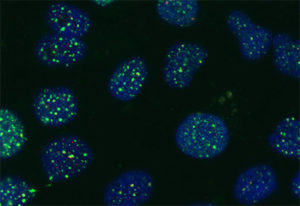
Northwestern Medicine scientists have identified proteins that mediate aspects of virus replication in the lifecycle of human papillomavirus (HPV), a finding that may lead to new therapeutic targets for treatment of infections caused by the virus.
“What we show, for the first time, are the proteins that hold chromatin together during mitosis, or cell replication, are the same proteins that play an important role in the DNA damage response in these viral infections,” said Laimonis Laimins, PhD, chair of Microbiology-Immunology.
The study, recently published in PLOS Pathogens, describes two cell proteins as critical regulators of viral replication; SMC1, a protein that bridges DNA together when cells divide, and CTCF, a protein that binds together strands of DNA to form loops that can either repress or enhance gene expression.
When the scientists reduce the genetic expression of these proteins, they found HPV was unable to replicate. They also confirmed that CTCF and SMC1 binding was critical to genome amplification, through mutating CTCF sites on the HPV genome. Reduction in the expression of CTCF resulted in the loss of the ability for SMC1 to interact with the HPV genome.

“This research is interesting because it show the ways in which the virus may interact with our own DNA,” said Kavi Mehta, first author of the paper and a third-year graduate student in the Walter S. and Lucienne Driskill Graduate Program in Life Sciences. “The importance of this research is understanding the life cycle of this virus. Now that we have a little bit of a greater understanding of how the virus maintains itself through the cell lifecycle, we might be able to find ways to prevent or understand how the virus evades the immune system.”
Next, Mehta plans to investigate how HPV uses these proteins to bring in other factors that allow the virus to replicate.
“These are small steps to figuring out this entire virus life cycle that is important for HPV biology,” Mehta said. “Once we know more about that, then this knowledge could be used as a base for developing therapeutics.”
The research was funded by National Cancer Institute grants CA59655 and CA142861, and the Cellular and Molecular Basis of Disease Training Grant T32 NIH T32 GM08061.






